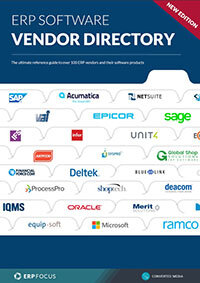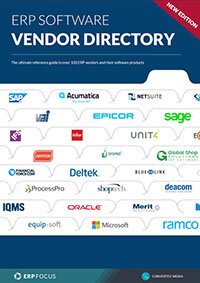ERP and e-commerce integration: a complete guide
Integrating an ecommerce system and an ERP system can help centralize and distribute data, and create a streamlined flow of information within your business. And while integrating your ERP with your ecommerce site comes with many benefits, it can carry quite the list of challenges, too. There’s no doubt that integration can be difficult, but with the right logic, strategy, initiative, and methodology you can push those difficulties to the wayside.
Should you integrate?
First things first: How are your sales? Are your web sales overshadowing last year’s numbers or rendering your brick-and-mortar shops useless? Are you savvy to the type of buying power e-commerce is commanding and do you want to jump on the growing opportunities available?
E-commerce integration is often pushed to the side on account of the challenge of changing systems, the overall breadth of the endeavor, the cost involved, and the time necessary. But those challenges are well overshadowed by the benefits that come with a unified platform that can improve sales, cut operational costs, and take advantage of unsaturated online markets.
Recommended reading: find vendors who offer ERP and e-commerce integration with our completely up-to-date ERP vendor directory.
What are the benefits?
ERPs destroy the data silos that keep your business from running like a well-oiled machine. With all of your data from ordering and shipping to customer communications and inventory purchases on one platform, no one is left in the dark.
An ERP system also eliminates manual entry of existing data and the redundancy that comes with transferring data from one system to another, saving you time and eliminating errors.
The ability to produce and analyze reports in real-time can keep you on top of the fast-paced trading of the e-commerce environment, without having to wait for data transfer or piece together information from multiple sources. This allows for instantaneous course corrections that can save at-risk revenue opportunities.
Customer connections are improved, and information for sales and support representatives is available at the touch of a button. This leads to improved brand loyalty and upward-bounding sales numbers.
And finally, an ERP and e-commerce integration makes your business location-independent. Inventory and pricing can be uniform across locations and product levels, information, and pricing changes are instantly communicated across the entire sales team, wherever they may be.
How is it done?
Fortunately, technology naturally becomes more flexible over time. There are many options to choose from, including custom solutions, multichannel management, or point-to-point options. No one option is necessarily better than another, they simply provide different benefits that may or may not suit your unique business.
First, understand where your data should live. Map out where each data element is stored, and which system is in charge of holding that data. Once you have a good understanding of where your data resides, you can choose the best integration methodology for that data.
Point-to-point connectors
This solution is an affordable option for smaller businesses. In a point-to-point connector, the e-commerce arm of your business is pointed at your ERP in order to exchange information and keep data in sync. That simplifies the management process and eliminates any data “middlemen” in between systems that require additional management.
This can be plenty for a smaller operation or one whose sales are slow and steady. But if your business is experiencing drastic growth or you anticipate additional sales channels in the near future, it’s likely better to select an ERP solution that can evolve along with your business, without requiring reconfigurations every time you expand.
Custom e-commerce ERP integration
Though more time-consuming and expensive, a custom e-commerce integration may be just the ticket if your backend systems require special handling. For instance, if you have plenty of APIs in multiple systems that need to interconnect to ensure that data flows seamlessly to and from your company’s many data boroughs.
If your business runs like no other, then this is the option for you. If not, a standardized approach can be the best option without having to forfeit extra time and money.
Multichannel management platforms
This type of option can be best suited to the standard e-commerce ERP integration endeavor as it provides a hub between systems and synchronizes data from multiple channels. This supports growth that can otherwise be cumbersome in point-to-point configurations, and prohibitively expensive in custom configurations. The often cloud-based multichannel management platform offers the best of both worlds with an affordable, yet robust, opportunity to streamline your operation.
A lack of automation and system integration is a mistake waiting to happen. To help your e-commerce business thrive and support future growth, you need an e-commerce strategy that supports your business as it stands today, and how it will evolve tomorrow. ERP integrations can help you maintain good data integrity, remove redundancies and productivity sinkholes, grow your business effectively, and help you provide better customer service to help you improve brand loyalty and keep your online sales at an all-time high.
Free white paper

ERP Software Vendor Directory
Put the most comprehensive ERP vendor directory on your desk today

Featured white papers
-

ERP Implementation: 9 steps to success
The 9 proven steps you should follow when implementing ERP
Download -

ERP Implementation Checklist
Over 120 actionable steps to implementing a new ERP successfully
Download -

Manufacturing ERP Implementation Checklist
Over 70 actionable steps to rolling out new manufacturing ERP software
Download
Related articles
-

Nine signs you need an eCommerce ERP integration
A guest blog from Brightpearl discussing eCommerce ERP and integration
-

Secret KPI: Why Your ERP Implementation Team Matters More Than Software
Learn how Godlan ensures successful ERP implementation for manufacturers with proven strategies &...
-

The case for multi-tier ERP implementations
Learn more about multi-tier ERP implementation and why you might need one

